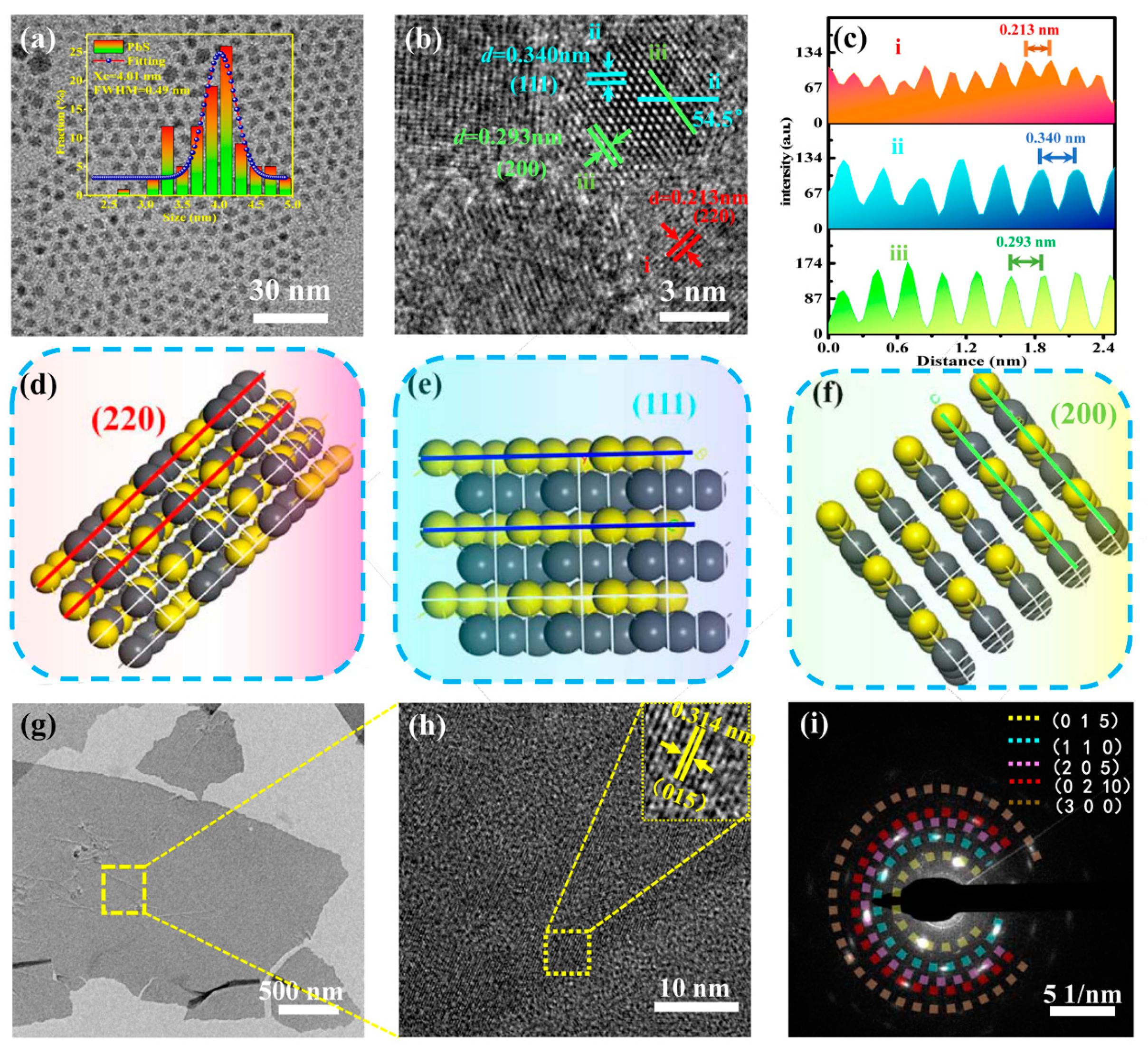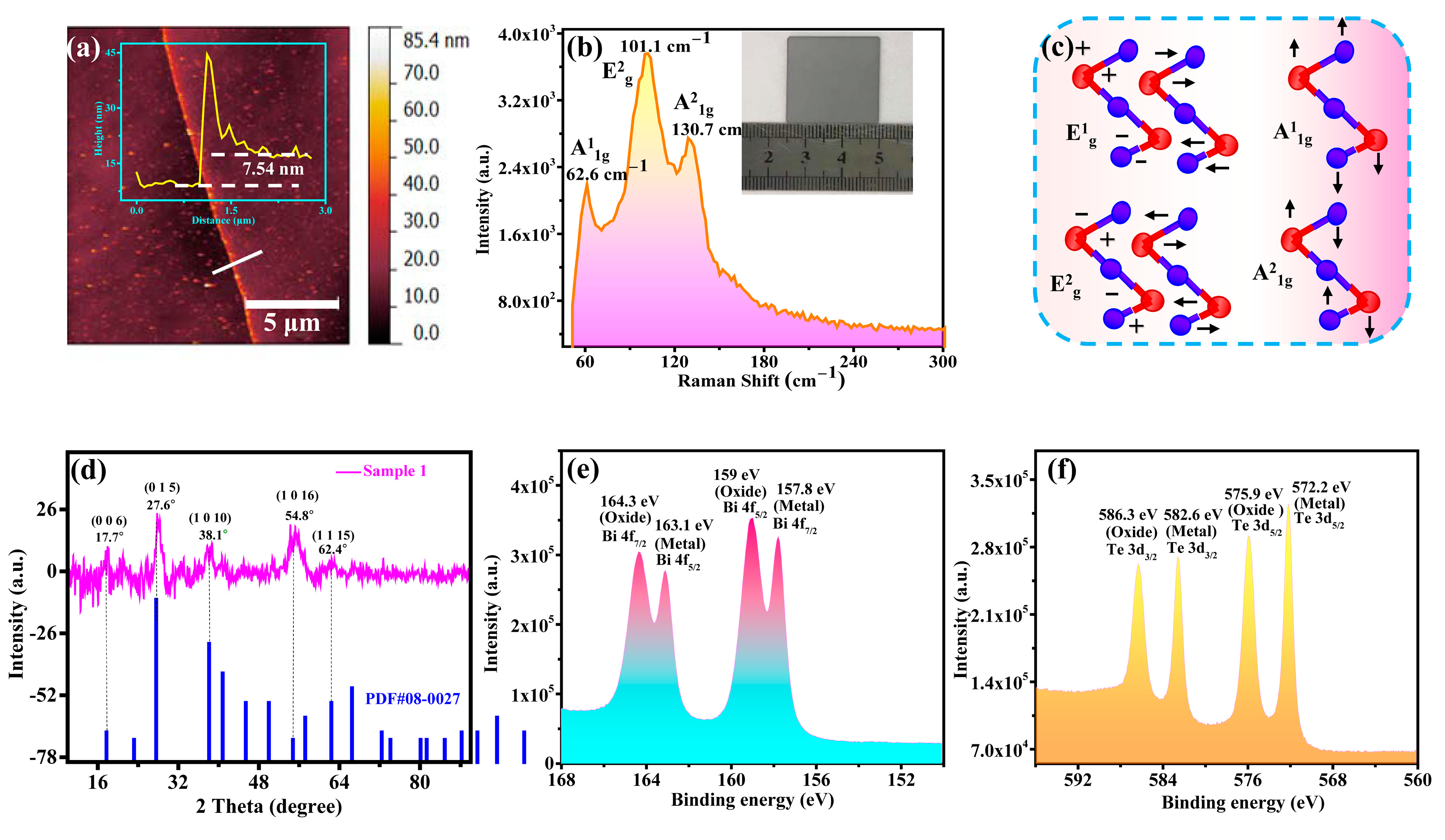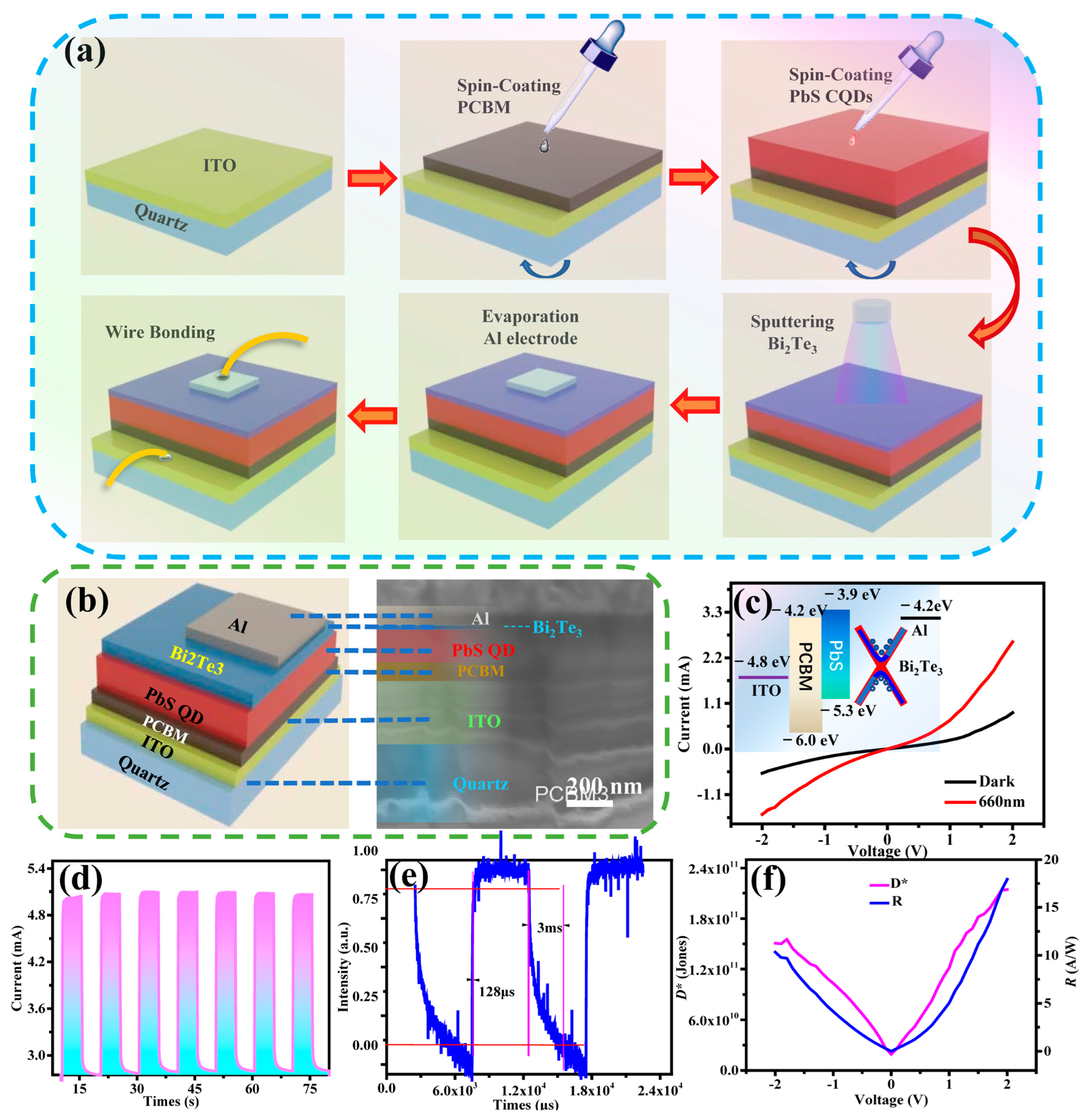Fast-Response Photodetector Based on Hybrid Bi2Te3/PbS Colloidal Quantum Dots
Abstract
:1. Introduction
2. Materials and Methods
2.1. Materials
2.2. Device Fabrication
3. Results and Discussion
4. Conclusions
Supplementary Materials
Author Contributions
Funding
Data Availability Statement
Acknowledgments
Conflicts of Interest
References
- Martyniuk, P.; Kopytko, M.; Rogalski, A. Barrier infrared detectors. Opto-Electron. Rev. 2014, 22, 127–146. [Google Scholar] [CrossRef]
- Liu, M.; Yazdani, N.; Yarema, M.; Jansen, M.; Wood, V.; Sargent, E.H. Colloidal quantum dot electronics. Nat. Electron. 2021, 4, 548–558. [Google Scholar] [CrossRef]
- Chuang, C.H.; Brown, P.R.; Bulovic, V.; Bawendi, M.G. Improved performance and stability in quantum dot solar cells through band alignment engineering. Nat. Mater. 2014, 13, 796–801. [Google Scholar] [CrossRef]
- McDonald, S.A.; Konstantatos, G.; Zhang, S.; Cyr, P.W.; Klem, E.J.; Levina, L.; Sargent, E.H. Solution-processed PbS quantum dot infrared photodetectors and photovoltaics. Nat. Mater. 2005, 4, 138–142. [Google Scholar] [CrossRef]
- Pradhan, S.; Di Stasio, F.; Bi, Y.; Gupta, S.; Christodoulou, S.; Stavrinadis, A.; Konstantatos, G. High-efficiency colloidal quantum dot infrared light-emitting diodes via engineering at the supra-nanocrystalline level. Nat. Nanotechnol. 2019, 14, 72–79. [Google Scholar] [CrossRef]
- Yin, X.; Zhang, C.; Guo, Y.; Yang, Y.; Xing, Y.; Que, W. PbS QD-based photodetectors: Future-oriented near-infrared detection technology. J. Mater. Chem. C 2021, 9, 417–438. [Google Scholar] [CrossRef]
- Saran, R.; Curry, R.J. Lead sulphide nanocrystal photodetector technologies. Nat. Photonics 2016, 10, 81–92. [Google Scholar] [CrossRef]
- Kovalenko, M.V.; Scheele, M.; Talapin, D.V. Colloidal nanocrystals with molecular metal chalcogenide surface ligands. Science 2009, 324, 1417–1420. [Google Scholar] [CrossRef] [PubMed]
- Malgras, V.; Nattestad, A.; Yamauchi, Y.; Dou, S.X.; Kim, J.H. The effect of surface passivation on the structure of sulphur-rich PbS colloidal quantum dots for photovoltaic application. Nanoscale 2015, 7, 5706–5711. [Google Scholar] [CrossRef] [PubMed]
- Brown, P.R.; Kim, D.; Lunt, R.R.; Zhao, N.; Bawendi, M.G.; Grossman, J.C.; Bulović, V. Energy Level Modification in Lead Sulfide Quantum Dot Thin Films through Ligand Exchange. ACS Nano 2014, 8, 5863–5872. [Google Scholar] [CrossRef]
- Nian, Q.; Gao, L.; Hu, Y.; Deng, B.; Tang, J.; Cheng, G.J. Graphene/PbS-Quantum Dots/Graphene Sandwich Structures Enabled by Laser Shock Imprinting for High Performance Photodetectors. ACS Appl. Mater. Interfaces 2017, 9, 44715–44723. [Google Scholar] [CrossRef]
- Jeong, H.; Song, J.H.; Jeong, S.; Chang, W.S. Graphene/PbS quantum dot hybrid structure for application in near-infrared photodetectors. Sci. Rep. 2020, 10, 12475. [Google Scholar] [CrossRef]
- Kufer, D.; Nikitskiy, I.; Lasanta, T.; Navickaite, G.; Koppens, F.H.; Konstantatos, G. Hybrid 2D-0D MoS2-PbS quantum dot photodetectors. Adv. Mater. 2015, 27, 176–180. [Google Scholar] [CrossRef]
- Zhang, H.; Liu, C.-X.; Qi, X.-L.; Dai, X.; Fang, Z.; Zhang, S.-C. Topological insulators in Bi2Se3, Bi2Te3 and Sb2Te3 with a single Dirac cone on the surface. Nat. Phys. 2009, 5, 438–442. [Google Scholar] [CrossRef]
- Wang, K.; Liu, Y.; Wang, W.; Meyer, N.; Bao, L.H.; He, L.; Lang, M.R.; Chen, Z.G.; Che, X.Y.; Post, K.; et al. High-quality Bi2Te3 thin films grown on mica substrates for potential optoelectronic applications. Appl. Phys. Lett. 2013, 103, 031605. [Google Scholar] [CrossRef]
- Wang, Z.; Li, M.; Yang, L.; Zhang, Z.; Gao, X.P.A. Broadband photovoltaic effect of n-type topological insulator Bi2Te3 films on p-type Si substrates. Nano Res. 2016, 10, 1872–1879. [Google Scholar] [CrossRef]
- Hines, M.A.; Scholes, G.D. Colloidal PbS Nanocrystals with Size-Tunable Near-Infrared Emission: Observation of Post-Synthesis Self-Narrowing of the Particle Size Distribution. Adv. Mater. 2003, 15, 1844–1849. [Google Scholar] [CrossRef]
- Kullmann, W.; Geurts, J.; Richter, W.; Lehner, N.; Rauh, H.; Steigenberger, U.; Eichhorn, G.; Geick, R. Effect of Hydrostatic and Uniaxial Pressure on Structural Properties and Raman Active Lattice Vibrations in Bi2Te3. Phys. Status Solidi (B) 1984, 125, 131–138. [Google Scholar] [CrossRef]
- Jeong, M.-W.; Na, S.; Shin, H.; Park, H.-B.; Lee, H.-J.; Joo, Y.-C. Thermomechanical In Situ Monitoring of Bi2Te3 Thin Film and Its Relationship with Microstructure and Thermoelectric Performances. Electron. Mater. Lett. 2018, 14, 426–431. [Google Scholar] [CrossRef]
- Souza, S.M.; Trichês, D.M.; Poffo, C.M.; de Lima, J.C.; Grandi, T.A.; de Biasi, R.S. Structural, thermal, optical, and photoacoustic study of nanocrystalline Bi2Te3 produced by mechanical alloying. J. Appl. Phys. 2011, 109, 013512. [Google Scholar] [CrossRef]
- Wang, C.; Zhu, X.; Nilsson, L.; Wen, J.; Wang, G.; Shan, X.; Zhang, Q.; Zhang, S.; Jia, J.; Xue, Q. In situ Raman spectroscopy of topological insulator Bi2Te3 films with varying thickness. Nano Res. 2013, 6, 688–692. [Google Scholar] [CrossRef]
- Li, S.; Fan, T.; Liu, X.; Liu, F.; Meng, H.; Liu, Y.; Pan, F. Graphene Quantum Dots Embedded in Bi2Te3 Nanosheets To Enhance Thermoelectric Performance. ACS Appl. Mater. Interfaces 2017, 9, 3677–3685. [Google Scholar] [CrossRef] [PubMed]
- Ahmad, M.; Agarwal, K.; Mehta, B.R. An anomalously high Seebeck coefficient and power factor in ultrathin Bi2Te3 film: Spin–orbit interaction. J. Appl. Phys. 2020, 128, 035108. [Google Scholar] [CrossRef]
- Tarachand; Saxena, M.; Okram, G.S.; Lakhani, A.; Kuo, Y.K.; Tyagi, S.; Behera, P.; Bhalerao, G.M.; Sathe, V.; Deshpande, U. Enhanced thermoelectric performance of solution-grown Bi2Te3 nanorods. Mater. Today Energy 2021, 21, 100700. [Google Scholar] [CrossRef]
- Fu, J.; Song, S.; Zhang, X.; Cao, F.; Zhou, L.; Li, X.; Zhang, H. Bi2Te3 nanoplates and nanoflowers: Synthesized by hydrothermal process and their enhanced thermoelectric properties. CrystEngComm 2012, 14, 2159. [Google Scholar] [CrossRef]
- Sarkar, S.S.; Mukherjee, S.; Khatri, R.K.; Ray, S.K. Solution-processed MoS2 quantum dot/GaAs vertical heterostructure based self-powered photodetectors with superior detectivity. Nanotechnology 2020, 31, 135203. [Google Scholar] [CrossRef]
- Wang, J.; Chen, J. High-sensitivity silicon: PbS quantum dot heterojunction near-infrared photodetector. Surf. Interfaces 2022, 30, 101945. [Google Scholar] [CrossRef]
- Xu, J.; Wang, H.; Yang, S.; Ni, G.; Zou, B. High-sensitivity broadband colloidal quantum dot heterojunction photodetector for night-sky radiation. J. Alloy Compd. 2018, 764, 446–451. [Google Scholar] [CrossRef]
- Zheng, L.; Zhou, W.; Ning, Z.; Wang, G.; Cheng, X.; Hu, W.; Zhou, W.; Liu, Z.; Yang, S.; Xu, K.; et al. Ambipolar Graphene-Quantum Dot Phototransistors with CMOS Compatibility. Adv. Opt. Mater. 2018, 6, 1800985. [Google Scholar] [CrossRef]
- Nikitskiy, I.; Goossens, S.; Kufer, D.; Lasanta, T.; Navickaite, G.; Koppens, F.H.; Konstantatos, G. Integrating an electrically active colloidal quantum dot photodiode with a graphene phototransistor. Nat. Commun. 2016, 7, 11954. [Google Scholar] [CrossRef] [Green Version]
- Hu, C.; Dong, D.; Yang, X.; Qiao, K.; Yang, D.; Deng, H.; Yuan, S.; Khan, J.; Lan, Y.; Song, H.; et al. Synergistic Effect of Hybrid PbS Quantum Dots/2D-WSe2Toward High Performance and Broadband Phototransistors. Adv. Funct. Mater. 2017, 27, 1603605. [Google Scholar] [CrossRef]



| Device | Excitation Wavelength (nm) | Rise/Fall Time | Responsivity (A/W) | Detectivity (Jones) | Ref. |
|---|---|---|---|---|---|
| PCBM/PbS-TBAl/Bi2Te3 | 660 | 128 (μs)/3 (ms) | 18 | 2.1 × 1011 | This work |
| PbS-TBAI/SiNx/Si | 1064/1310 | 160/320 (μs) | 0.68/0.29 | 7.74 × 1010/3.32 × 1010 | [27] |
| ZnO/PbS-TBAl/PbS-EDT | 500/910 | 25.5/25.6 (ms) | 385/444 | 3.9 × 1013/4.52 × 1013 | [28] |
| PbS-QD/graphene | 1550 | 3/200 (ms) | 104 | 1012 | [29] |
| PbS-QD/graphene | 635/1600 | -/200 (ms) | - | 4 × 1012 | [30] |
| PbS-QD/WSe2 | 970 | 7/480 (ms) | 2 × 105 | 7 × 1013 | [31] |
| PbS-QD/MoS2 | 400–1500 | -/0.3 (s) | 6 × 105 | 5 × 1011 | [13] |
Publisher’s Note: MDPI stays neutral with regard to jurisdictional claims in published maps and institutional affiliations. |
© 2022 by the authors. Licensee MDPI, Basel, Switzerland. This article is an open access article distributed under the terms and conditions of the Creative Commons Attribution (CC BY) license (https://creativecommons.org/licenses/by/4.0/).
Share and Cite
Yu, L.; Tian, P.; Tang, L.; Hao, Q.; Teng, K.S.; Zhong, H.; Yue, B.; Wang, H.; Yan, S. Fast-Response Photodetector Based on Hybrid Bi2Te3/PbS Colloidal Quantum Dots. Nanomaterials 2022, 12, 3212. https://doi.org/10.3390/nano12183212
Yu L, Tian P, Tang L, Hao Q, Teng KS, Zhong H, Yue B, Wang H, Yan S. Fast-Response Photodetector Based on Hybrid Bi2Te3/PbS Colloidal Quantum Dots. Nanomaterials. 2022; 12(18):3212. https://doi.org/10.3390/nano12183212
Chicago/Turabian StyleYu, Lijing, Pin Tian, Libin Tang, Qun Hao, Kar Seng Teng, Hefu Zhong, Biao Yue, Haipeng Wang, and Shunying Yan. 2022. "Fast-Response Photodetector Based on Hybrid Bi2Te3/PbS Colloidal Quantum Dots" Nanomaterials 12, no. 18: 3212. https://doi.org/10.3390/nano12183212





